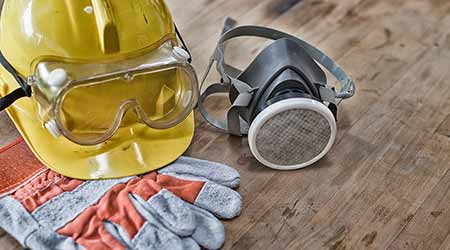4 Steps to Personal Protection
Effective worker protection goes well beyond gloves and goggles
Personal protective equipment (PPE) is essential for protecting front-line technicians in institutional and commercial buildings. But many questions remain about the most effective ways to properly select and use these key products.
By understanding safety standards and regulations, as well as trends in PPE product design, materials and performance, maintenance and engineering managers will be able to select PPE products to address goals related to the safety, performance and comfort of technicians.
Managers are required by the Occupational Safety and Health Administration (OSHA) to furnish “a place of employment which is free from recognized hazards that are causing or are likely to cause death or serious physical harm to his employees.” Because of this requirement, employers need to identify and address workplace hazards, including those workers encounter in a manner capable of causing injury or impairment in the function of any part of the body through absorption, inhalation or physical contact. Workplace hazards include those associated with processes or environment, chemical hazards, radiological hazards, and mechanical irritants.
Four steps to protection
Identify and reduce hazards. The first step for managers is to identify workplace hazards. Once hazards are identified, managers must eliminate or reduce them using the hierarchy of controls. Simply stated, OSHA regulations require that the use of PPE must be the last option for controlling workplace hazards. OSHA mandates that employers use engineering and administrative controls to reduce or eliminate hazards before considering the use of PPE.
An example of an engineering control would be to use ventilation to control carbon monoxide exhaust from a generator. An example of an administrative control would be to prohibit eating, drinking, and smoking in areas where workers can ingest chemical contamination. Identify PPE needs. Unfortunately, engineering or administrative controls cannot completely eliminate many workplace hazards, so managers turn to PPE to address remaining workplace hazards. An example of PPE use under the OSHA hierarchy controls would be the use of gloves and eye protection when using maintenance chemicals where skin irritation or splashing into the eyes might occur.
Managers should give specific consideration to the basic hazard categories, including impact, penetration, compression, chemical, heat, harmful dust, light — optical — and radiation. Area walkthroughs can identify the sources of these hazards, including:
- motion — machinery, tools, collisions
- high temperatures that could result in burns, eye injury or ignition
- chemical exposures
- harmful dust
- light and radiation, i.e., welding, brazing, cutting, furnaces, heat treating, and high-intensity lights
- falling objects or the potential for dropping objects
- sharp objects that might pierce feet or cut hands
- rolling or pinching objects that could crush the feet
- electrical hazards.
Managers also should review injury and accident data and chemical safety data sheets to help identify known problem areas. Other workplace hazards — such as noise, asbestos, heavy metals, radiation, and silica — also might require exposure monitoring to determine if workers have selected appropriate PPE.
Managers must document the hazard assessment to demonstrate compliance. OSHA provides hazard identification guidance on selecting PPE in its non-mandatory Appendix B of the PPE standard found here: https://goo.gl/yz3SoU
Pay for PPE. OSHA regulations require that the employer must provide most PPE at no cost to employees. Employers also must pay for replacement PPE, except when the employee has lost or intentionally damaged the PPE. OSHA provides numerous interpretation letters that provide more insight to managers with questions on paying for PPE.
OSHA does not require employers to pay for non-specialty safety-toe protective footwear — including steel toe shoes or boots — and non-specialty prescription safety eyewear if they permit workers to wear such items off the jobsite.
Additional items that OSHA has identified as not having to be paid for by the employer include everyday clothing, such as long-sleeve shirts, long pants, street shoes, and normal work boots. Other excluded items include ordinary clothing, skin creams, and other items used solely for protection from weather, such as winter coats, jackets, gloves, parkas, rubber boots, hats, raincoats, ordinary sunglasses, and sunscreen.
Ensure compliance. Proper use and care for PPE involves training and proper fit. OSHA mandates that managers train each employee who is required to use eye and face protection, head, foot, and hand protection on the following:
- when and what PPE is necessary
- how to don, doff, adjust, and wear PPE
- PPE limitations
- proper care, maintenance, useful life, and disposal of PPE.
This training should occur annually and be documented.
OSHA also might require written programs and medical clearance. For instance, the use of respiratory protection requires employee training, as well as a written respiratory protection plan. The use of respiratory protection first requires that managers provide medical clearance for employees before they are assigned respirators. This medical clearance ensures that respirators will not cause a hazard to workers if they are required to wear them.
Once respirators are assigned, managers must ensure proper fit of respiratory protection by performing fit-testing of employees annually, and employees must perform fit seal-checks each time they put on a respirator.
Related Topics:














